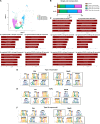Dietary methionine restriction started late in life promotes healthy aging in a sex-specific manner
- PMID: 40238871
- PMCID: PMC12002124
- DOI: 10.1126/sciadv.ads1532
Dietary methionine restriction started late in life promotes healthy aging in a sex-specific manner
Abstract
Aging is associated with dysregulated methionine metabolism and increased levels of enzymes in the tyrosine degradation pathway (TDP). To investigate the efficacy of targeting either methionine metabolism or the TDP for healthspan improvement in advanced age, we initiated dietary MetR or TDP inhibition in 18-month-old C57BL/6J mice. MetR significantly improved neuromuscular function, metabolic health, lung function, and frailty. In addition, we confirmed improved neuromuscular function from dietary MetR in 5XFAD mice, whose weight was not affected by MetR. We did not observe benefits with TDP inhibition. Single-nucleus RNA and ATAC sequencing of muscle revealed cell type-specific responses to MetR, although MetR did not significantly affect mouse aging epigenetic clock markers. Similarly, an 8-week MetR intervention in a human trial (NCT04701346) showed no significant impact on epigenetic clocks. The observed benefits from late-life MetR provide translational rationale to develop MetR mimetics as an antiaging intervention.
Figures







References
-
- Lopez-Otin C., Blasco M. A., Partridge L., Serrano M., Kroemer G., Hallmarks of aging: An expanding universe. Cell 186, 243–278 (2023). - PubMed
MeSH terms
Substances
Grants and funding
- P30 AG024827/AG/NIA NIH HHS/United States
- U54 AG054345/AG/NIA NIH HHS/United States
- P30 AG013319/AG/NIA NIH HHS/United States
- P30 AG068635/AG/NIA NIH HHS/United States
- R03 AG075651/AG/NIA NIH HHS/United States
- U54 AG075931/AG/NIA NIH HHS/United States
- K01 DK115543/DK/NIDDK NIH HHS/United States
- R35 GM146869/GM/NIGMS NIH HHS/United States
- R01 HL135062/HL/NHLBI NIH HHS/United States
- S10 OD023684/OD/NIH HHS/United States
- R21 DK121266/DK/NIDDK NIH HHS/United States
- R01 DK138967/DK/NIDDK NIH HHS/United States
- R01 AG082696/AG/NIA NIH HHS/United States
- R00 AG057792/AG/NIA NIH HHS/United States
- R01 AG070034/AG/NIA NIH HHS/United States
LinkOut - more resources
Full Text Sources
Medical
Molecular Biology Databases

